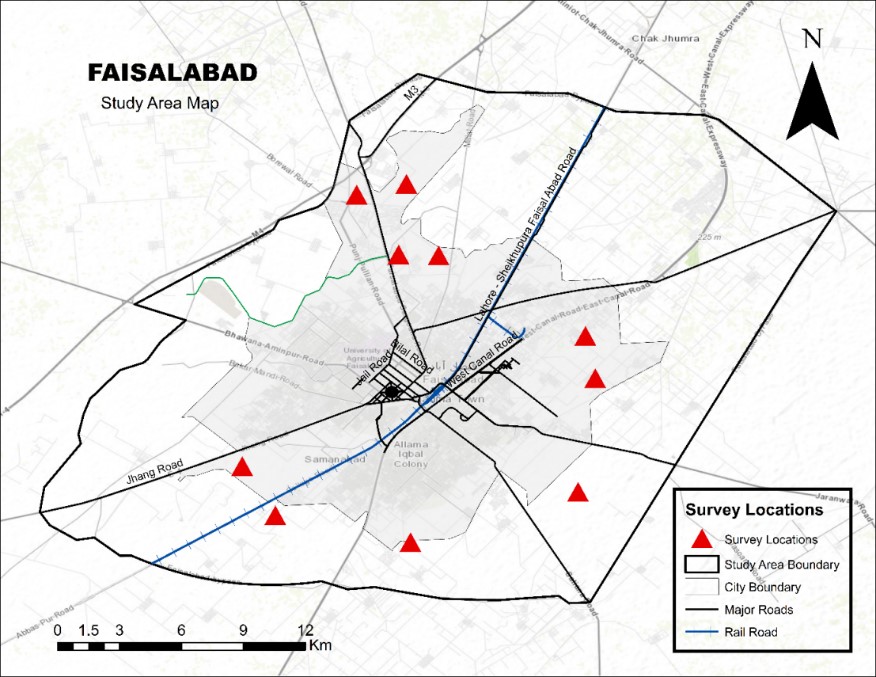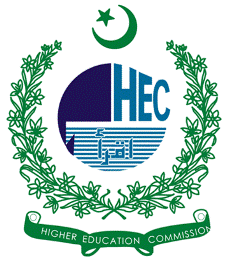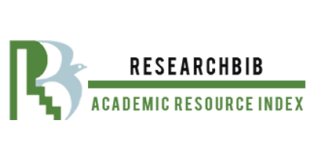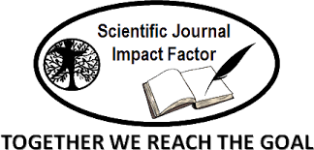Impact of Peri-Urban Agriculture on Food Self-Sufficiency of Faisalabad
Exploring the Contribution of Per-Urban Agriculture to Sustainable Food Systems in Faisalabad
Keywords:
Peri Urban Agriculture, Food security, Food Access, Food Self-Sufficiency, Nutrient-Rich Crops, Urban Planning, Nutritional ImpactAbstract
Introduction/ Importance of Study: Peri-urban agriculture plays a vital role in enhancing food self-sufficiency and improving nutritional outcomes, particularly in growing cities like Faisalabad, Punjab. This study assesses how it affects local production, household food supply, and stakeholder integration along the urban–rural interface.
Materials and Methods: Data were collected from 100 peri-urban farming households in Faisalabad using structured questionnaires. The survey included variables such as land ownership, crop types, agricultural income, and vegetable consumption. Additionally, land use changes from 2018 to 2023 were analyzed using GIS tools to observe the impact of urban expansion. Descriptive statistics and Chi-Square tests were applied to assess relationships between food access, nutritional perceptions, and consumption patterns.
Results and Discussion: Findings revealed that households allocated an average of 12.9 Kanals for agriculture, growing seasonal vegetables like turnip, carrot, spinach, and peas. Nearly half of the produce was consumed domestically, while the remainder was sold locally. A significant association (p < 0.05) was found between positive nutritional perceptions and regular access to fresh produce. However, limited government support, weak stakeholder coordination, and inadequate market access emerged as key barriers.
Conclusion: Peri-urban agriculture significantly contributes to household nutrition and food access in Faisalabad. Yet, its broader impact is limited by institutional gaps. Strengthening collaboration among farmers, policymakers, extension workers, and markets is essential for making peri-urban agriculture more resilient and sustainable in urban Pakistan.
References
M. Korth et al., “What are the impacts of urban agriculture programs on food security in low and middle-income countries: A systematic review,” Environ. Evid., vol. 3, no. 1, pp. 1–10, 2014, doi: 10.1186/2047-2382-3-21.
J. H. Check, B. Katsoff, D. Summers-Chase, and J. Breitbart, “A case report supporting the concept that some women have a predisposition for maternal meiosis errors resulting in digyny,” Clin. Exp. Obstet. Gynecol., vol. 36, no. 2, pp. 133–134, 2009.
M. A. F. Pierre Paul Audate, “Scoping review of the impacts of urban agriculture on the determinants of health,” BMC Public Health, 2019.
C. K. Kirby et al., “Differences in motivations and social impacts across urban agriculture types: Case studies in Europe and the US,” Landsc. Urban Plan., vol. 212, no. March, 2021, doi: 10.1016/j.landurbplan.2021.104110.
S. S. and R. P. M. K. Bashir, “REGIONAL SENSITIVITY OF RURAL HOUSEHOLD FOOD SECURITY: THE CASE OF PUNJAB, PAKISTAN,” J. Anim. Plant Sci., vol. 23, no. 4, 2013.
M. N. Poulsen, P. R. McNab, M. L. Clayton, and R. A. Neff, “A systematic review of urban agriculture and food security impacts in low-income countries,” Food Policy, vol. 55, pp. 131–146, Aug. 2015, doi: 10.1016/J.FOODPOL.2015.07.002.
S. Chen, “AGRIHOOD : a new peri-urban agriculture system for Auckland : towards a sustainable farming centered residential development,” 2016.
A. Bocquier, F. Vieux, S. Lioret, C. Dubuisson, F. Caillavet, and N. Darmon, “Socio-economic characteristics, living conditions and diet quality are associated with food insecurity in France,” Public Health Nutr., vol. 18, no. 16, pp. 2952–2961, 2015, doi: 10.1017/S1368980014002912.
E. E. M. Donald L. Chi, “Socioeconomic Status, Food Security, and Dental Caries in US Children: Mediation Analyses of Data From the National Health and Nutrition Examination Survey, 2007–2008,” Am. J. Public Health, 2014.
T. Aidoo, R., Mensah, J. O., & Tuffour, “Sekyere-Afram Plains District of Ghana,” 1st Annu. Int. Interdiscip. Conf., 2013.
E. Sraboni, H. J. Malapit, A. R. Quisumbing, and A. U. Ahmed, “Women’s empowerment in agriculture: What role for food security in Bangladesh?,” World Dev., vol. 61, pp. 11–52, 2014, doi: 10.1016/j.worlddev.2014.03.025.
A. Gaines, C. A. Robb, L. L. Knol, and S. Sickler, “Examining the role of financial factors, resources and skills in predicting food security status among college students,” Int. J. Consum. Stud., vol. 38, no. 4, pp. 374–384, 2014, doi: 10.1111/ijcs.12110.
B. T. Omonona and G. A. Agoi, “An analysis of food security situation among Nigerian urban households: Evidence from Lagos state, Nigeria,” J. Cent. Eur. Agric., vol. 8, no. 3, pp. 397–406, 2007.
N. L. Bushra Pervaiz, “Socio-Economic Characteristics of Farming Community and Food Security Situation in Punjab, Pakistan,” J. Agric. Sci., 2017.
S. Panezai et al., “Rural households’ food security and its determinants in coastal regions of Bangladesh,” Nat. Resour. Forum, vol. 46, no. 2, pp. 200–220, 2022, doi: 10.1111/1477-8947.12250.
F. Carlet, J. Schilling, and M. Heckert, “Greening U.S. legacy cities: urban agriculture as a strategy for reclaiming vacant land,” Agroecol. Sustain. Food Syst., vol. 41, no. 8, pp. 887–906, 2017, doi: 10.1080/21683565.2017.1311288.
R. Kessler, “Urban gardening: Managing the risks of contaminated soil,” Environ. Health Perspect., vol. 121, no. 11–12, pp. 326–333, 2013, doi: 10.1289/ehp.121-A326.
I. Säumel, I. Kotsyuk, M. Hölscher, C. Lenkereit, F. Weber, and I. Kowarik, “How healthy is urban horticulture in high traffic areas? Trace metal concentrations in vegetable crops from plantings within inner city neighbourhoods in Berlin, Germany,” Environ. Pollut., vol. 165, pp. 124–132, 2012, doi: 10.1016/j.envpol.2012.02.019.
M. Warming, M. G. Hansen, P. E. Holm, J. Magid, T. H. Hansen, and S. Trapp, “Does intake of trace elements through urban gardening in Copenhagen pose a risk to human health?,” Environ. Pollut., vol. 202, pp. 17–23, 2015, doi: 10.1016/j.envpol.2015.03.011.
M. W. Laura Whitzling, “Testing and Educating on Urban Soil Lead: A Case of Chicago Community Gardens,” J. Agric. Food Syst. Community Dev., vol. 1, no. 2, p. 1, 2011.
P. Bhargaw, A., & Chauhan, “Analysis of soilless farming in urban agriculture,” J. Pharmacogn. Phytochem., vol. 9, no. 3, pp. 239–242, 2020.
M. Rasheed, R. ., Ishaq, M. N. ., & Akbar, “A Correlation of Socio-economic Determinants and Food Security Status in Pakistan,” Pakistan J. Humanit. Soc. Sci., 2022.
J. F. Pete Falloon, Daniel P Bebber, Carole Dalin, John Ingram, Dann Mitchell, Tom N Hartley, Penny J Johnes, Tim Newbold, Andrew J Challinor, “What do changing weather and climate shocks and stresses mean for the UK food system?,” Environ. Res. Lett., vol. 17, no. 5, 2022.
A. Doernberg, I. Zasada, K. Bruszewska, B. Skoczowski, and A. Piorr, “Potentials and limitations of regional organic food supply: A qualitative analysis of two food chain types in the Berlin Metropolitan region,” Sustain., vol. 8, no. 11, 2016, doi: 10.3390/su8111125.
I. Zasada, “Multifunctional peri-urban agriculture-A review of societal demands and the provision of goods and services by farming,” Land use policy, vol. 28, no. 4, pp. 639–648, 2011, doi: 10.1016/j.landusepol.2011.01.008.
S. C. Guido Sali, “Urban-Rural Relationships in Feeding Metropolis: A Case Study in Ljubljana Metropolitan Area,” Adv. Eng. Forum, vol. 11, no. 6, 2024.
H. Sawadogo-Lingani, J. Owusu-Kwarteng, R. Glover, B. Diawara, M. Jakobsen, and L. Jespersen, “Sustainable production of african traditional beers with focus on dolo, a West African sorghum-based alcoholic beverage,” Front Sustain Food Syst, vol. 5, May 2021, doi: 10.3389/fsufs.2021.672410/full.
J. D. Gatrell, N. Reid, and P. Ross, “Local food systems, deserts, and maps: The spatial dynamics and policy implications of food geography,” Appl. Geogr., vol. 31, no. 4, pp. 1195–1196, 2011, doi: 10.1016/j.apgeog.2011.01.013.
F. Waskow, “Verluste vom Acker bis auf den Teller: Lebensmittelabfälle in der Wertschöpfungskette und im Konsum,” LEBENSMITTELABFÄLLE, 2018.
M. E. Schipanski et al., “Realizing resilient food systems,” Bioscience, vol. 66, no. 7, pp. 600–610, 2016, doi: 10.1093/biosci/biw052.
J. E. Kurtz, P. B. Woodbury, Z. U. Ahmed, and C. J. Peters, “Mapping U.S. Food System Localization Potential: The Impact of Diet on Foodsheds,” Environ. Sci. Technol., vol. 54, no. 19, pp. 12434–12446, 2020, doi: 10.1021/acs.est.9b07582.
C. H. Judith Rüschhoff, “Potentials and perspectives of food self-sufficiency in urban areas—a case study from Leipzig,” Renew. Agric. Food Syst., 2022.
R. Ahmed, U. Mustafa, and A. U. Khan, “Socio-economic status of transferred and non-Transferred urban slums: A case study from faisalabad,” Pak. Dev. Rev., vol. 54, no. 4, pp. 947–962, 2015, doi: 10.30541/v54i4i-iipp.947-962.
M. N. Bhalli, “Remote Sensing and Gis Applications for Monitoring and Assessment of the Urban Sprawl in Faisalabad-Pakistan,” Pak. J. Sci., vol. 64, no. 3, pp. 203–208, 2023, doi: 10.57041/pjs.v64i3.535.
A. Bras, “Éléments pour une définition de la problématique de la propreté urbaine en Haïti : le cas de Port-au-Prince.,” Quisqueya, Feb. 2010, doi: 10.54226/UNIQ.EDSE.68864.
L. V. Moya KNEAFSEY, “Short Food Supply Chains and Local Food Systems in the EU. A State of Play of their Socio-Economic Characteristics,” JRC Sci. Policy Reports, 2013.
S. Berg, “Snowball Sampling—I,” Encycl. Stat. Sci., Dec. 2005, doi: 10.1002/0471667196.ESS2478.PUB2.
G. R. Sadler, H. C. Lee, R. S. H. Lim, and J. Fullerton, “Recruitment of hard-to-reach population subgroups via adaptations of the snowball sampling strategy,” Nurs. Heal. Sci., vol. 12, no. 3, pp. 369–374, 2010, doi: 10.1111/j.1442-2018.2010.00541.x.
Seyyed Hossein Nasr and Mehdi Aminrazavi, “Introductory Analysis,” An Anthol. Philos. Persia, May 2020, doi: 10.5040/9780755610129.0009.
S. Yamane, “Instructions for use INSECTA MATSUMURANA,” Doctor, 1990.
Sami Ul-Allah, “Socio-economic aspects of fodder production in Urban and peri-urban of Faisalabad,” Pakistan J. Agric. Res., vol. 51, no. 2, pp. 483–490, 2014.

Downloads
Published
How to Cite
License
Copyright (c) 2025 50sea

This work is licensed under a Creative Commons Attribution 4.0 International License.




















